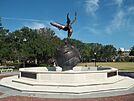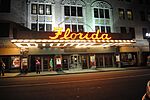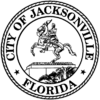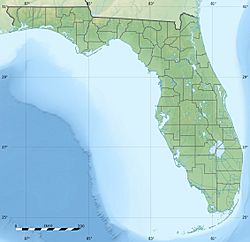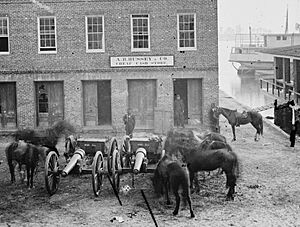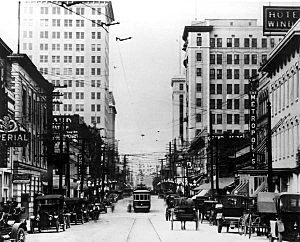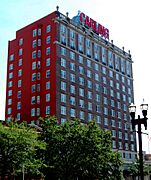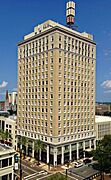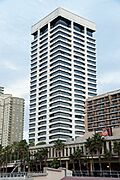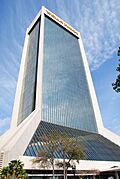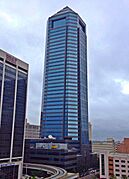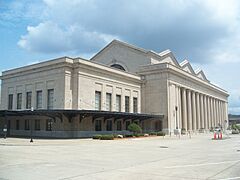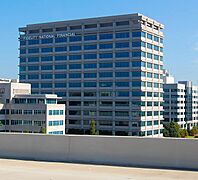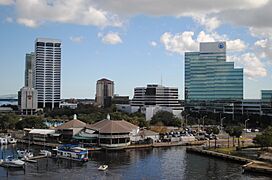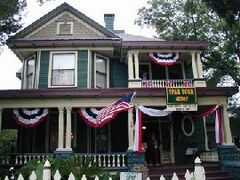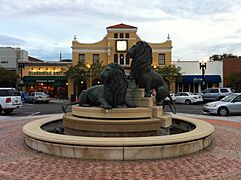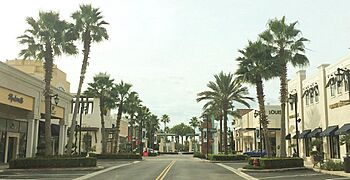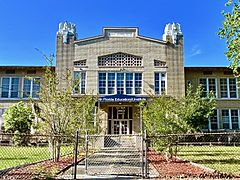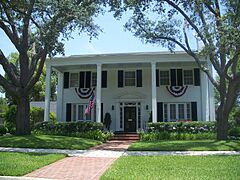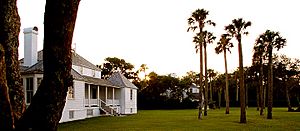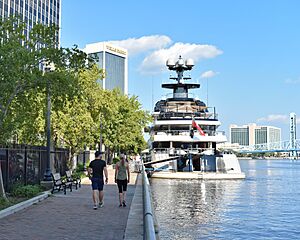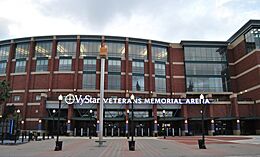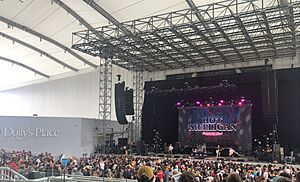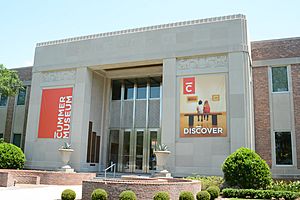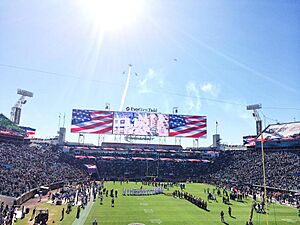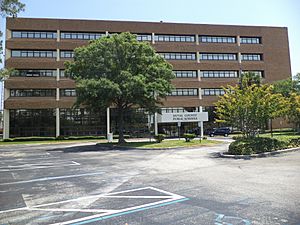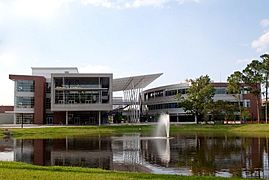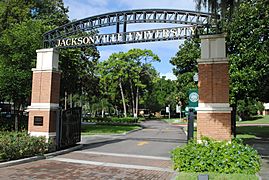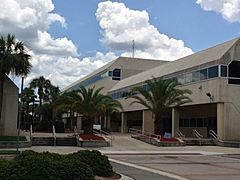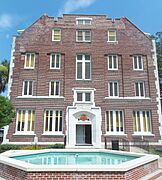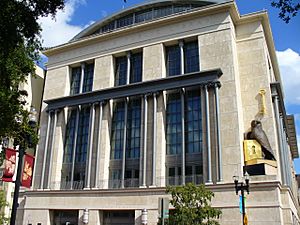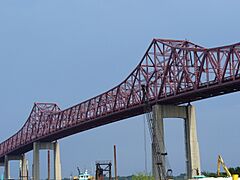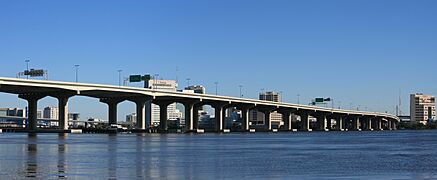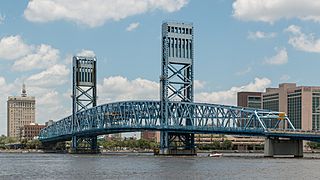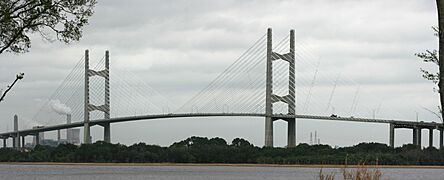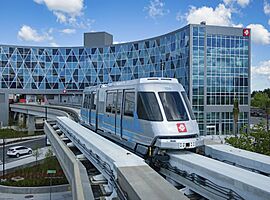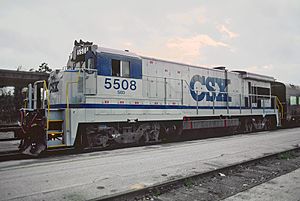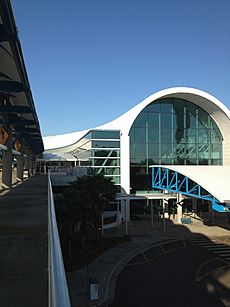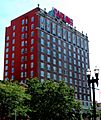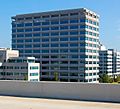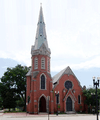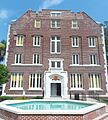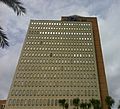Jacksonville, Florida facts for kids
Quick facts for kids
Jacksonville
|
|||
|---|---|---|---|
|
Consolidated city–county
|
|||
| City of Jacksonville and Duval County | |||
|
Port of Jacksonville
EverBank Stadium
|
|||
|
|||
| Nicknames:
"Jax", "The River City", The Bold New City of the South
|
|||
| Motto(s):
Where Florida Begins, It's Easier Here
|
|||
| Country | |||
| State | |||
| County | Duval | ||
| Founded | June 15, 1822 | ||
| Incorporated | February 9, 1832 | ||
| Consolidated | October 1, 1968 | ||
| Named for | Andrew Jackson | ||
| Government | |||
| • Type | Strong Mayor–Council | ||
| • Body | Jacksonville City Council | ||
| Area | |||
| • Total | 874.46 sq mi (2,264.84 km2) | ||
| • Land | 747.30 sq mi (1,935.49 km2) | ||
| • Water | 127.16 sq mi (329.35 km2) | ||
| Elevation | 16 ft (5 m) | ||
| Population
(2020)
|
|||
| • Total | 949,611 | ||
| • Estimate
(July 2023)
|
990,931 | ||
| • Rank | 31st in North America 10th in the United States 1st in Florida |
||
| • Density | 1,270.73/sq mi (490.63/km2) | ||
| • Urban | 1,247,374 (US: 40th) | ||
| • Urban density | 2,175.9/sq mi (840.1/km2) | ||
| • Metro | 1,733,937 (US: 38th) | ||
| Demonyms | Jaxon, Jacksonvillian | ||
| GDP | |||
| • Metro | 9.095 billion (2023) | ||
| Time zone | UTC−5 (Eastern (EST)) | ||
| • Summer (DST) | UTC−4 (EDT) | ||
| ZIP Codes |
32099, 32201–32212, 32214–32241, 32244–32247, 32250, 32254–32260, 32266, 32267, 32277, 32290
|
||
| Area codes | 904, 324 | ||
| FIPS code | 12-35000 | ||
| GNIS feature ID | 0295003 | ||
| Website | City of Jacksonville | ||
Jacksonville is the biggest city in Florida by population and land area. It's located on Florida's Atlantic coast. Jacksonville is also the main city of Duval County. In 1968, the city and county governments joined together, which made Jacksonville much larger. By 2023, it became the 10th largest city in the United States by population.
Jacksonville is sometimes called "Jax" or "The River City" because the St. Johns River runs through it. The city is about 12 miles (19 km) south of the Georgia state line and 350 miles (563 km) north of Miami. The nearby Jacksonville Beaches are right on the Atlantic Ocean.
Long ago, the Timucua people lived here. In 1564, the French built a colony called Fort Caroline, which was one of the first European settlements in the U.S. Later, under British rule, a settlement grew where cattle crossed the river, known as the Cow Ford. In 1822, a town was officially started and named Jacksonville, after Andrew Jackson, who was a famous general and later a U.S. President.
Jacksonville has a very important port because of its location on the river. This helps with trade and is home to several U.S. Navy bases, making it a major military center. The city's economy also relies on banking, insurance, healthcare, and shipping. Tourism is also a big part of the economy, especially for golf fans, as the PGA Tour headquarters is nearby. People from Jacksonville are often called Jacksonvillians or Jaxons.
Contents
History of Jacksonville
Early Beginnings
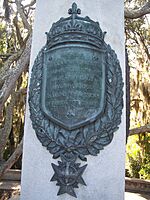
People have lived in the Jacksonville area for thousands of years. Very old pottery, dating back to 2500 BCE, has been found here.
In the 1500s, the Mocama people, a group of the Timucua, lived along the coast. Their main villages were near the mouth of the St. Johns River. One old map shows a village called Ossachite where downtown Jacksonville is today.
In 1562, a French explorer named Jean Ribault explored the St. Johns River. He called it the River of May and claimed the land for France. In 1564, another French explorer, René Goulaine de Laudonnière, started the first European settlement on the river, called Fort Caroline.
However, Spain wanted to control Florida. In 1565, Spanish forces attacked Fort Caroline and took it over, renaming it San Mateo. After this, St. Augustine became the most important Spanish settlement in Florida.
In 1763, Spain gave Florida to the British. The British built the King's Road, which connected St. Augustine to Georgia. This road crossed the St. Johns River at a narrow spot called the Cow Ford, where cattle could cross.
British settlers came to Florida and started growing crops like sugarcane and indigo. They also exported lumber. Many British colonists moved to the area, bringing the English language and their legal system.
After the American Revolutionary War, Britain gave Florida back to Spain in 1783. The settlement at the Cow Ford continued to grow.
Founding and the 1800s
In 1821, the United States took control of Florida from Spain. American settlers at the Cow Ford decided to plan a town. They named it Jacksonville, honoring Andrew Jackson, who was a war hero and the first governor of the Florida Territory. The town officially became a city on February 9, 1832.
During the American Civil War, Jacksonville was an important supply point for the Confederate forces. The city was taken over by both Union and Confederate forces several times. Union forces eventually held the city for the rest of the war.
After the war, during the Reconstruction period, Jacksonville became a popular winter vacation spot for wealthy people. Visitors came by steamboat and later by train. However, outbreaks of yellow fever and the expansion of railroads further south caused tourism to decline in the late 1800s.
The 1900s and Today
The Great Fire of 1901

On May 3, 1901, a huge fire started in downtown Jacksonville. It spread quickly, destroying 146 city blocks and over 2,000 buildings. About 10,000 people lost their homes, and seven people died. The fire was so big that its glow could be seen in Savannah, Georgia, and smoke plumes reached Raleigh, North Carolina. This event, known as the "Great Fire of 1901", was one of the worst disasters in Florida's history. Architect Henry John Klutho played a big role in rebuilding the city.
Jacksonville's Film Industry
In the 1910s, many film studios from the North came to Jacksonville. They liked the warm weather, beautiful scenery, good train access, and cheap labor. More than 30 silent film studios opened, making Jacksonville the "Winter Film Capital of the World". However, when Hollywood became a major film center, Jacksonville's film industry declined. Today, the Norman Studios remains as the Jacksonville Silent Film Museum.
During this time, Jacksonville also grew as a center for banking and insurance companies.
Growth and Consolidation
During World War II, the U.S. Navy became a huge employer in Jacksonville, building three Navy bases.
After World War II, many people moved from the city center to the suburbs. This caused problems for the city, as its tax money decreased, making it hard to pay for schools and other services. In 1968, the city and county governments decided to join together. This was called Jacksonville Consolidation. Voters approved the plan, and on October 1, 1968, the Consolidated City of Jacksonville was created. This made the city much larger, covering about 900 square miles.
Recent History
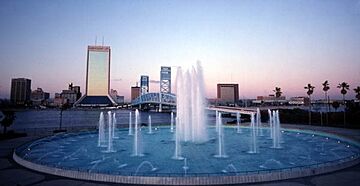
In the 1990s, Mayor Ed Austin started the River City Renaissance program, which used $235 million to improve downtown Jacksonville. He also helped the city get its National Football League team, the Jacksonville Jaguars, in 1993.
In 2000, voters approved the Better Jacksonville Plan, which used a small sales tax to fund $2.25 billion in projects. These projects included road improvements, environmental protection, and new public buildings.
In 2005, Jacksonville hosted Super Bowl XXXIX, a very big football game.
A unique event happened in Jacksonville on May 22, 2010. Someone bought two pizzas from Papa John's using 10,000 Bitcoin, which was one of the first real-world purchases made with the digital currency. This day is now known as "Bitcoin Pizza Day" among crypto fans.
Jacksonville has also faced natural disasters. In 2016, Hurricane Matthew caused major flooding and damage. In 2017, Hurricane Irma brought record-breaking floods to the city.
Jacksonville's Geography
City Layout
Jacksonville is a very large city, covering about 874 square miles (2,264 km²). This makes it one of the largest cities by land area in the contiguous United States. The city is built along both sides of the St. Johns River. The Trout River, a major branch of the St. Johns River, is also entirely within Jacksonville.
The soil in Jacksonville is mostly sand and clay, so there are not many sinkholes.
City Buildings
Most buildings in downtown Jacksonville were built after the Great Fire of 1901. The city has many buildings in the Prairie School style, which was popular in the early 1900s. Architects like Henry John Klutho helped rebuild the city with new and interesting designs. Jacksonville also has many Mid-Century modern buildings from the mid-1900s.
Many of Florida's first skyscrapers were built in Jacksonville. The tallest building in downtown Jacksonville is the Bank of America Tower, which is 617 feet (188 meters) tall and has 42 floors. Other tall buildings include 1 Independent Square and the Riverplace Tower.
-
Laura Street Trio (1902–1912)
-
The Carling (1925)
-
11 East Forsyth (1926)
-
Eight Forty One (1955)
-
Riverplace Tower (1967)
-
TIAA Bank Center (1983)
Neighborhoods
Jacksonville has over 500 neighborhoods! Some of the main areas include Downtown Jacksonville, Northside, Westside, Southside, Arlington, and the Jacksonville Beaches.
Four towns within Jacksonville have their own governments: Baldwin, Atlantic Beach, Neptune Beach, and Jacksonville Beach. Several neighborhoods, like Avondale and Riverside, are recognized as historic districts.
Climate and Weather
Jacksonville has a humid subtropical climate. This means it has hot, humid summers and warm, drier winters. Most of the rain falls from May to September, often in short, strong thunderstorms. The driest months are from November to April. On average, Jacksonville gets about 52 inches (1.3 meters) of rain each year.
Temperatures usually range from about 54°F (12°C) in January to 82°F (28°C) in July. It rarely gets very cold, usually only 10 to 15 nights a year are at or below freezing. The coldest temperature ever recorded was 7°F (-14°C) in 1985. Jacksonville has only seen measurable snow three times since 1911.
Jacksonville has only been directly hit by one hurricane since 1871, Hurricane Dora in 1964. However, the city often experiences strong winds and heavy rain from hurricanes that pass nearby. Recent hurricanes like Hurricane Matthew (2016) and Hurricane Irma (2017) caused significant flooding and damage.
Parks and Green Spaces
Jacksonville has a huge park system, with over 337 parks covering more than 80,000 acres (32,000 hectares). Many parks offer chances to boat, swim, fish, and enjoy the water.
National Parks
The Timucuan Preserve is a U.S. National Preserve with over 46,000 acres (18,600 hectares) of wetlands and waterways. It includes historic sites like the Fort Caroline National Memorial and the Kingsley Plantation, which is the oldest standing plantation in Florida.
State Parks
Several state parks are located within Jacksonville, including Amelia Island State Park, Big Talbot Island State Park, and Little Talbot Island State Park. These parks offer beautiful natural areas to explore.
City Parks
- Springfield Park is a public park in the historic Springfield neighborhood. It opened in 1907 and was renamed Springfield Park in 2020.
- Friendship Fountain is a large fountain in St. Johns River Park. When it opened in 1965, it was the world's largest and tallest fountain. It's a popular attraction with a light and music show every evening.
- Hanna Park is a 1.5-mile (2.4 km) public beach and city park near Mayport. It has 447 acres (181 hectares) of coastal forest and was once Florida's first beach community for African Americans during segregation.

- James Weldon Johnson Park is a 1.54-acre (0.62 hectare) public park in downtown Jacksonville. It's the city's oldest park and hosts events like the Art Walk and Jaxsons Night Market.
- Jacksonville-Baldwin Rail Trail is a 14.5-mile (23.3 km) trail for hiking, biking, and horseback riding.
- Jessie Ball DuPont Park is home to Treaty Oak, a massive 250-year-old tree.
- Metropolitan Park is a 32-acre (13 hectare) waterfront park on the St. Johns River with an exhibition area and a performance stage.
- Memorial Park honors the 1,200 Floridians who died in World War I. It was designed by famous landscape architects.
- The Riverwalk is a path along the St. Johns River, perfect for walking and enjoying the views.
- Veterans Memorial Wall honors local service members who died while serving in the U.S. armed forces.
Other Attractions
- Jacksonville Zoo and Gardens has a large collection of animals, including elephants, lions, and jaguars.
- Tree Hill Nature Center is a nature preserve and education center close to downtown.
People of Jacksonville
Jacksonville is a diverse city. In 2020, the population was 949,611 people.
- About 47.8% of the population was White (not Hispanic).
- About 30.0% was Black or African American.
- About 11.6% was Hispanic or Latino.
- About 5.0% was Asian.
Jacksonville has the largest Albanian American community in Florida. It also has Florida's largest Filipino American community, many of whom have ties to the United States Navy.
Religion
Jacksonville has many different religious groups. The largest group is Protestant Christians. There are also many Roman Catholic churches, Eastern Orthodox churches, and other Christian groups.
The city has a growing Muslim community with several mosques. The Jewish community is mainly in the Mandarin neighborhood, with different types of synagogues. There are also communities of Hindus, Buddhists, and Baháʼís.
Jacksonville's Economy
Jacksonville's location on the St. Johns River and the Atlantic Ocean is very important for its economy. It has a large port that handles many goods, especially automobile imports. The city is a major transportation and distribution center for Florida.
Jacksonville's economy is diverse, meaning it has many different types of businesses. These include shipping, financial services, healthcare, and manufacturing.
Several large companies have their main offices in Jacksonville, including CSX Corporation (a railroad company) and Fidelity National Financial (a financial services company). The U.S. military is the biggest employer in Jacksonville.
Banking and Finance
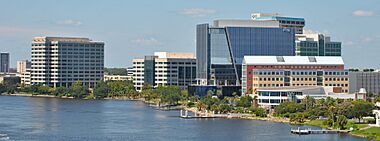
Jacksonville has a long history in banking and finance. Many financial companies have moved some of their operations to Jacksonville because of lower costs and a good quality of life. Deutsche Bank has its second-largest U.S. operation here, after New York City. Other big banks like Bank of America and Wells Fargo also have a strong presence in the city.
Shipping and Logistics
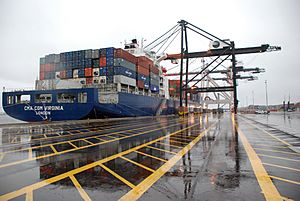
Jacksonville is a key hub for rail, air, and highway transportation. The Port of Jacksonville (JAXPORT) is a very busy seaport. It handles millions of tons of cargo each year, including many cars. About 50,000 jobs in Northeast Florida are connected to the port.
Cecil Commerce Center is a large industrial and business area on the site of a former Navy base. It has excellent transportation links, including a very long runway.
Media and Technology
The Florida Times-Union is Jacksonville's main daily newspaper. There are also weekly papers focusing on business and local news.
Jacksonville is a significant market for television and radio. Major TV networks like NBC, ABC, CBS, and Fox have stations here. Many radio stations play different types of music, from pop to hip-hop to country.
Military and Defense
Jacksonville is home to three U.S. Navy bases: Naval Air Station Jacksonville, Naval Station Mayport, and Blount Island Command. Together with a nearby submarine base, this makes Jacksonville the third-largest naval complex in the country. The military is the biggest employer in Jacksonville, bringing in about $6.1 billion to the economy each year.

- Naval Air Station Jacksonville employs about 23,000 people and has facilities for pilot training and aircraft maintenance.
- Naval Station Mayport is a large Navy ship base that can hold many ships. It used to be home to the aircraft carrier USS John F. Kennedy.
- Blount Island Command is a Marine Corps base that helps quickly send equipment and supplies to military forces.
The Florida Air National Guard is also based at Jacksonville International Airport. The Coast Guard Sector Jacksonville helps control operations along the coast.
Culture and Fun
Things to Do
Jacksonville hosts many events throughout the year.
- The annual Gate River Run is a 15 km (9.3 miles) road race, the largest of its kind in the U.S.
- The Gator Bowl is a college football game held around New Year's Day.
- The Florida–Georgia game, a big college football rivalry, is held almost every year in Jacksonville.
- The Jacksonville Kingfish Tournament is a large fishing competition with many prizes.
- River City Pride is Northeast Florida's biggest Gay Pride parade.
Cultural events include:
- The Jacksonville Jazz Festival, one of the largest jazz festivals in the nation.
- Springing the Blues, one of the oldest blues festivals, held at Jacksonville Beach.
- The World of Nations Celebration, which features food and culture from different countries.
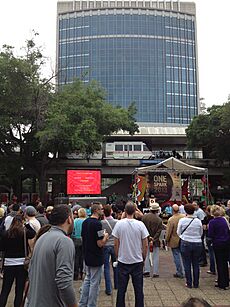
- The Art Walk, a monthly outdoor art festival.
- Riverside Arts Market (RAM), an outdoor market for arts and crafts.
For entertainment:
- The VyStar Veterans Memorial Arena hosts live sports and concerts.
- Daily's Place is an amphitheater next to EverBank Field that hosts concerts.
- The Jacksonville Zoo and Gardens has the second-largest animal collection in Florida.
- Theatre Jacksonville is one of the oldest community theaters in the U.S.
- Alhambra Theater & Dining is the oldest continuously operated dinner theater in the U.S.
Jacksonville has two main shopping malls: Regency Square Mall and The Avenues Mall. There are also outdoor shopping centers like St. Johns Town Center and River City Marketplace.
Museums and Art
- The Cummer Museum of Art and Gardens has large collections of American, European, and Japanese art, plus beautiful gardens.
- The Museum of Contemporary Art Jacksonville (MOCA Jacksonville) focuses on modern art and is part of the University of North Florida.
- The Museum of Science & History (MOSH) has exhibits on science and local history, plus the only planetarium in the area.
- Kingsley Plantation is a historic plantation from 1798, with preserved buildings and slave cabins.
- The Karpeles Manuscript Library Museum displays original manuscripts and documents.
- The Jacksonville Fire Museum has over 500 artifacts, including an 1806 hand pumper.
- The LaVilla Museum focuses on African-American history and art.
Music Scene
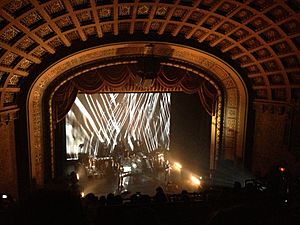
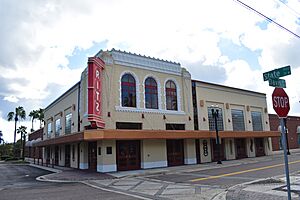
The Ritz Theatre in the LaVilla neighborhood was a popular spot for music in the 1930s. Famous Black musicians like Cab Calloway and Ella Fitzgerald performed there. Ray Charles even played piano at the Ritz for a year when he was young. The Ritz Theatre was rebuilt and reopened in 1999.
The Jacksonville Jazz Festival has been held for over 40 years.
Jacksonville is known as the birthplace of Southern Rock music, with bands like the Allman Brothers Band and Lynyrd Skynyrd forming here in the 1960s and 70s. Later, bands like Limp Bizkit and many hip hop artists also became famous from Jacksonville.
The Times-Union Center for the Performing Arts has three halls for Broadway shows, symphony concerts, and smaller performances.
Sports Teams
| Club | Sport | League | Venue (capacity) |
|---|---|---|---|
| Jacksonville Jaguars | Football | NFL | TIAA Bank Field (69,428) |
| Sporting Club Jacksonville | Soccer | USLC | TBD |
| Jacksonville Jumbo Shrimp | Baseball | IL | 121 Financial Ballpark (11,000) |
| Jacksonville Giants | Basketball | ABA | VyStar Veterans Memorial Arena (14,100) |
| Jacksonville Icemen | Ice hockey | ECHL | VyStar Veterans Memorial Arena (13,000) |
| Jacksonville Sharks | Indoor football | IFL | VyStar Veterans Memorial Arena (13,000) |
| Jacksonville Axemen | Rugby league | USARL | Hodges Stadium (12,000) |
| Jacksonville Armada FC | Soccer | MLS Next Pro | New Eastside Stadium |
| Jacksonville Saints | Australian Rules Football | USAFL | Willowbranch Park |
Jacksonville is home to one major professional sports team, the Jacksonville Jaguars of the National Football League (NFL). They play their home games at TIAA Bank Field. In 2005, Jacksonville hosted Super Bowl XXXIX.
The city also has several minor league teams:
- The Jacksonville Jumbo Shrimp are a Triple-A baseball team.
- The Jacksonville Sharks play indoor football.
- The Jacksonville Axemen are a rugby league team.
- The Jacksonville Giants are a basketball team.
- The Jacksonville Armada FC is a soccer team.
- The Jacksonville Icemen are a minor league ice hockey team.
All Elite Wrestling (AEW), a professional wrestling company, is also based in Jacksonville.
College sports, especially college football, are very popular. The city hosts the Florida–Georgia game and the TaxSlayer Gator Bowl. Jacksonville's two universities, the University of North Florida and Jacksonville University, compete in NCAA Division I sports.
Education in Jacksonville
Schools for Kids
Public schools in Jacksonville are managed by Duval County Public Schools. In the 2009–2010 school year, over 123,000 students attended 172 schools, including elementary, middle, and high schools. Many of these are magnet schools, which offer special programs.
Some of Jacksonville's high schools, like Stanton College Preparatory School and Paxon School for Advanced Studies, are often ranked among the top public high schools in the country.
There are also several private schools, including Catholic schools like Bishop Kenny High School.
Colleges and Universities
Jacksonville has several colleges and universities:
- The University of North Florida (UNF) is a public university.
- Jacksonville University (JU) is a private university.
- Edward Waters University (EWU) is the oldest college in Jacksonville and Florida's oldest historically black college.
- Florida State College at Jacksonville (FSCJ) offers two-year and some four-year degrees.
- The University of Florida has a campus here for its health science programs.
Public Libraries
The Jacksonville Public Library system started in 1878. Today, it has the Main Library and 20 branch libraries. The Main Library, which opened in 2005, is the largest public library in Florida. It has many books, special collections, and computers for public use. The library gets almost four million visitors each year.
City Infrastructure
Transportation in Jacksonville
Roads and Bridges
There are seven bridges that cross the St. Johns River in Jacksonville. These include the Napoleon Bonaparte Broward Bridge, the John E. Mathews Bridge, the Isaiah D. Hart Bridge, the John T. Alsop Jr. Bridge, the St. Elmo W. Acosta Bridge, the Fuller Warren Bridge, and the Henry Holland Buckman Bridge. There's also a large railroad bridge next to the Acosta Bridge.
Long ago, tolls were charged on some of these bridges, but they were removed in 1989 to help traffic flow better.
Major highways like Interstate 10 and Interstate 95 meet in Jacksonville, making it a very busy area for drivers. I-295 is a bypass route that goes around the downtown area.
Public Transit
The Jacksonville Skyway is an automated people mover system that connects different parts of downtown Jacksonville. It has eight stops and helps people get around quickly.
Most people in Jacksonville drive alone to work. About 80% of residents commute in single-occupancy vehicles.
Trains
Amtrak, the national passenger rail system, has daily service from the Jacksonville Amtrak Station. Two trains, the Silver Meteor and Silver Star, stop here.
Jacksonville is also the headquarters for two major freight railroads: CSX Transportation and Florida East Coast Railway.
Airports
Jacksonville is served by Jacksonville International Airport (JAX), which is about 13 miles (21 km) north of downtown. It has many daily flights to cities across the country. Smaller airports like Jacksonville Executive at Craig Airport and Cecil Airport are used for smaller planes. Cecil Airport is even designated as a spaceport!
Seaports
Public seaports in Jacksonville are managed by the Jacksonville Port Authority (JAXPORT). Jacksonville has four modern deepwater port facilities, including a cruise port. It's one of the top ports in the U.S. for handling cars.
The Mayport Ferry connects Mayport and Fort George Island, allowing cars to cross the St. Johns River.
Utilities

Basic utilities like water, sewer, and electricity are provided by JEA. People's Gas provides natural gas. Comcast and AT&T offer cable, internet, and phone services. Jacksonville also has a successful recycling program.
Notable People
Sister Cities
Jacksonville has several sister cities around the world:
 Bahía Blanca, Argentina (1967)
Bahía Blanca, Argentina (1967) Changwon, South Korea (1983)
Changwon, South Korea (1983) Nantes, France (1984)
Nantes, France (1984) Yingkou, China (1990)
Yingkou, China (1990) Nelson Mandela Bay, South Africa (2000)
Nelson Mandela Bay, South Africa (2000) Curitiba, Brazil (2009)
Curitiba, Brazil (2009) San Juan, Puerto Rico (2009)
San Juan, Puerto Rico (2009)
In 2000, Jacksonville won an award for its cultural program with Nantes.
Images for kids
-
Northeast Florida showing Cow Ford (center) from Bernard Romans' 1776 map of Florida
-
Section of a light battery by the St. Johns River in Jacksonville during the Civil War
-
Ruins of the courthouse and armory from the Great Fire of 1901
-
Crowd gathered for a campaign speech from Richard Nixon in Hemming Park in October 1960
-
From left to right: Northbank Jacksonville skyline and the Main Street Bridge
-
Laura Street Trio (1902–1912)
-
The Carling (1925)
-
11 East Forsyth (1926)
-
Eight Forty One (1955)
-
Riverplace Tower (1967)
-
TIAA Bank Center (1983)
-
Kingsley Plantation, located within the Timucuan Preserve
-
View of downtown, as seen from Springfield Park
-
CSX Transportation Building serves as headquarters for CSX Corporation.
-
From left to right: The headquarters of FIS, Black Knight, Inc., Fidelity National Financial, Cowford Wealth Management Group of Raymond James, and EverBank in Brooklyn.
-
Container ship at Port of Jacksonville
-
USS John F. Kennedy departing Naval Station Mayport
-
St. Andrew's Episcopal Church, built in 1887, is one of Jacksonville's oldest churches.
-
Hemming Park hosts a variety of cultural events throughout the year.
-
The XX performing at the Florida Theatre
-
The Ritz Theater, opened in 1929 in the LaVilla neighborhood. Renovated in 1999.
-
The Star-Spangled Banner performed before a Jacksonville Jaguars game at TIAA Bank Field
-
JEA headquarters in downtown Jacksonville
| Climate data for Jacksonville, Florida (Jacksonville Int'l), 1991−2020 normals, extremes 1871−present | |||||||||||||
|---|---|---|---|---|---|---|---|---|---|---|---|---|---|
| Month | Jan | Feb | Mar | Apr | May | Jun | Jul | Aug | Sep | Oct | Nov | Dec | Year |
| Record high °F (°C) | 87 (31) |
89 (32) |
94 (34) |
95 (35) |
100 (38) |
103 (39) |
105 (41) |
102 (39) |
100 (38) |
96 (36) |
89 (32) |
85 (29) |
105 (41) |
| Mean maximum °F (°C) | 80.4 (26.9) |
82.9 (28.3) |
86.4 (30.2) |
89.6 (32.0) |
94.1 (34.5) |
96.8 (36.0) |
97.4 (36.3) |
96.2 (35.7) |
93.4 (34.1) |
89.1 (31.7) |
84.6 (29.2) |
81.1 (27.3) |
98.4 (36.9) |
| Mean daily maximum °F (°C) | 65.5 (18.6) |
68.9 (20.5) |
74.3 (23.5) |
79.8 (26.6) |
85.9 (29.9) |
89.9 (32.2) |
91.9 (33.3) |
90.7 (32.6) |
87.1 (30.6) |
80.8 (27.1) |
73.1 (22.8) |
67.5 (19.7) |
79.7 (26.5) |
| Daily mean °F (°C) | 54.2 (12.3) |
57.5 (14.2) |
62.4 (16.9) |
68.1 (20.1) |
74.9 (23.8) |
80.3 (26.8) |
82.5 (28.1) |
82.1 (27.8) |
78.8 (26.0) |
71.2 (21.8) |
62.3 (16.8) |
56.7 (13.7) |
69.3 (20.7) |
| Mean daily minimum °F (°C) | 42.4 (5.8) |
45.6 (7.6) |
50.0 (10.0) |
55.8 (13.2) |
63.3 (17.4) |
70.2 (21.2) |
72.7 (22.6) |
72.9 (22.7) |
70.0 (21.1) |
61.1 (16.2) |
50.8 (10.4) |
45.3 (7.4) |
58.4 (14.7) |
| Mean minimum °F (°C) | 25.3 (−3.7) |
28.2 (−2.1) |
32.6 (0.3) |
40.8 (4.9) |
50.7 (10.4) |
62.5 (16.9) |
68.2 (20.1) |
68.1 (20.1) |
60.5 (15.8) |
44.8 (7.1) |
33.1 (0.6) |
29.2 (−1.6) |
23.5 (−4.7) |
| Record low °F (°C) | 7 (−14) |
10 (−12) |
23 (−5) |
31 (−1) |
45 (7) |
47 (8) |
61 (16) |
63 (17) |
48 (9) |
33 (1) |
21 (−6) |
11 (−12) |
7 (−14) |
| Average precipitation inches (mm) | 3.28 (83) |
2.86 (73) |
3.29 (84) |
2.93 (74) |
3.42 (87) |
7.60 (193) |
6.77 (172) |
6.88 (175) |
7.56 (192) |
4.03 (102) |
2.00 (51) |
2.78 (71) |
53.40 (1,356) |
| Average precipitation days (≥ 0.01 in) | 7.7 | 7.7 | 8.0 | 6.0 | 7.0 | 14.1 | 13.6 | 15.1 | 12.4 | 8.0 | 6.6 | 7.7 | 113.9 |
| Average relative humidity (%) | 74.9 | 72.2 | 71.2 | 69.5 | 72.7 | 76.8 | 77.7 | 80.3 | 80.8 | 78.6 | 77.7 | 76.7 | 75.8 |
| Mean monthly sunshine hours | 189.4 | 193.8 | 257.9 | 286.4 | 303.9 | 283.6 | 282.0 | 262.4 | 228.2 | 214.6 | 193.9 | 183.6 | 2,879.7 |
| Percent possible sunshine | 59 | 62 | 69 | 74 | 72 | 67 | 65 | 64 | 62 | 61 | 61 | 58 | 65 |
| Source: NOAA (relative humidity and sun 1961−1990) | |||||||||||||
See also
 In Spanish: Jacksonville (Florida) para niños
In Spanish: Jacksonville (Florida) para niños







